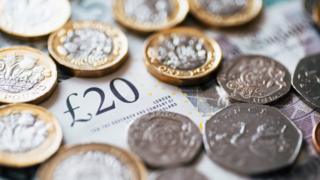UK government debt hits £2tn for first time
 Image copyright Getty Images
Image copyright Getty Images Total UK government debt has exceeded £2 trillion for the first time.
At the end of July, debt was £2.004tn, £227.6bn more than at the same point last year, the Office for National Statistics (ONS) said.
That means the government now owes more than the entire value of the country’s economy for the first time in 60 years.
Economists said this reflected the scale of the government’s efforts to tackle the pandemic and warned that it would get worse before it got better.
The government now owes the equivalent of 100.5% of gross domestic product (GDP) – the total value of all the goods and services produced in the economy.
It is the first time debt has been above 100% of GDP since the 1960-61 financial year, the ONS said.
‘Huge sum’
The government borrowed £26.7bn in July, down from a revised £29.5bn in June, as the coronavirus pandemic took its toll on the public finances.
The July figure – the difference between spending and tax income – was the fourth highest borrowing in any month since records began in 1993. The three higher figures were the previous three months.
«The £26.7bn the government borrowed in July was the lowest monthly borrowing figure since March as fiscal support started to unwind. Nonetheless, it is another huge sum and pushes borrowing in the year to date to £150.5bn,» said Ruth Gregory, senior UK economist at Capital Economics.
«That is close to the deficit for the whole of 2009-10 of £158.3bn, which was previously the largest cash deficit in history, reflecting the extraordinary fiscal support the government has put in place to see the economy through the crisis.»
Cautious chancellor?
Carl Emmerson, deputy director of the Institute for Fiscal Studies, told the BBC’s Today programme it was «not really a surprise» that the government was borrowing a lot of money, given the size of its efforts to support people hit by the pandemic.
However, he added that interest rates were so low that the government was actually spending less on servicing its debts than had been forecast before the coronavirus crisis.
The ONS cautioned that borrowing estimates were subject to «greater than usual uncertainty».
It said the June figure had been revised down by £6bn, largely because of stronger than previously estimated tax receipts and National Insurance contributions.
Samuel Tombs, chief UK economist at Pantheon Macroeconomics, said: «Public borrowing remains on course this year to hit its highest share of GDP since the Second World War, despite coming in below expectations over the last couple of months.
«Looking ahead, borrowing looks set to jump temporarily in August, as the government makes the second and last Self-Employment Income Support Scheme payment and funds the Eat Out to Help Out scheme.
«Thereafter, it will decline, as the Coronavirus Job Retention Scheme, which cost £6.9bn to operate in July, is wound down ahead of its closure at the end of October, and firms make a huge VAT payment in March, for sales generated in Q2, as well as in that month.»
However, he added that with borrowing for this financial year expected to be about 17% of GDP, Chancellor Rishi Sunak was likely to be «relatively cautious» in his autumn Budget.


